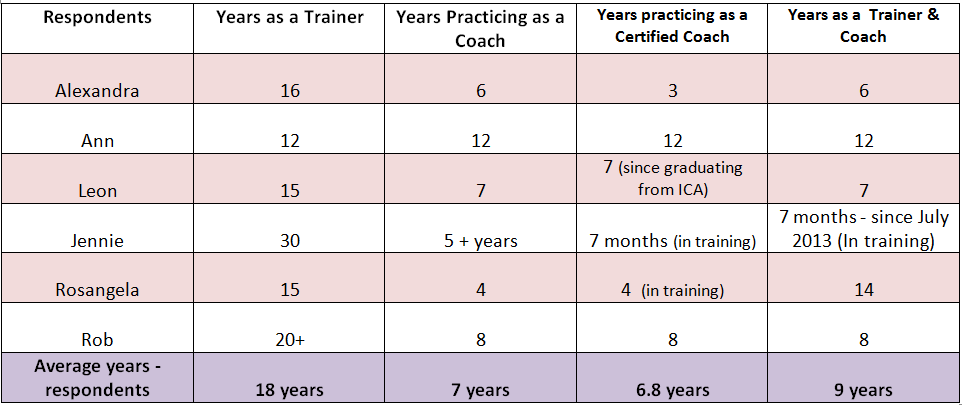Introduction
Training is an activity in which those with knowledge, experience and expertise in a certain field, share these with individuals to improve their performance on the job or in their personal lives. The reasons for training may be determined by: a training needs assessment (TNA), the supervisor through the performance management process; personal interest of the trainee, staff turnover, new technology, cost control, role and career flexibility, orientation, new appraisal techniques, globalization and speed of change, or improvement of product and service quality among others.Coaching is a nondirective process in which the expertise resides within the coachee. The coachee may self-refer, is referred by another coach, or by someone else. The coach uses listening skills and asks powerful questions to elicit the coachee’s expertise, skills and potential.
The implication of this research is how has coach training impacted: the design, facilitation and delivery of training; the use of training and coaching to complement each other, and the benefits to be derived by both trainees and coachees.
Definition of Terms 1.0 Training
Training as defined by FAO as:…essentially the instructing of others in information new to them and its application. It may, and often does, involve the teaching of new skills, methods and procedures… The most important element in a training situation is the trainer. The trainer who is enthusiastic, energetic and genuinely interested in both the subject and getting his or her message across will evoke the greatest response from the trainees. The trainer who lacks interest in training, who has little or no enthusiasm for the subject of the training and who merely goes through the motions of training is a failure. Such a trainer wastes not only his or her own time but also that of the trainees. The inept trainer is quickly identified by the trainees, who react with inattention, lassitude, undisciplined behaviour and absence from training sessions. Successful training – that which produces the desired result – lies almost entirely in the hands of thetrainer. In the trainer’s hands lies the heavy responsibility for ensuring that the trainees achieve the maximum possible from the training.
A measure of the success of training is the relationship that develops between trainer and trainees.
In a sound, productive training situation there is mutual respect and trust between them, with the trainer taking care to ensure that even the weakest trainee performs to the highest possible level, and the trainees feeling a desire within themselves to achieve. In this situation the trainer is the motivator and the trainees are the motivated (FAO, page 1, section 1, Introduction para 3-6). The writer selected this definition as it is not only comprehensive, but has some of the elements required in the coaching relationship.In the writer’s experience, an effective trainer is someone who:
2.0 Coaching
The International Coaching Federation (ICF) defines coaching as
partnering with clients in a thought-provoking and creative process that inspires them to maximize their personal and professional potential. Coaching is a distinct service and differs greatly from therapy, consulting, mentoring or training. Individuals who engage in a coaching relationship can expect to experience fresh perspectives on personal challenges and opportunities, enhanced thinking and decision-making skills, enhanced interpersonal effectiveness, and increased confidence in carrying out their chosen work and life roles (ICF, 2010, July. para 8).
Grant (1999) defines coaching as ‘a collaborative, solution-focused, results-oriented and systematic process in which the coach facilitates the enhancement of work performance, life experience, self-directed learning and personal growth of the coachee’ (p. 9 as seen in Passmore, J. 2010).
Coaching is ‘unlocking a person’s potential to maximize their own performance. It is helping them to learn rather than teaching them’ (Whitmore, 2009, in Passmore, J. , 2010 p. 9).
This paper will present findings of a survey of 6 respondents, and the writer’s experience both as a trainer and coach. The information was gathered via the writer-designed and administered questionnaire. One respondent completed and returned the questionnaire via email. All respondents, like the writer, have experienced a change in their delivery/facilitation of training since enrolment in a coach programme. In this report, the words coachee and client are used interchangeably.
Purpose of Research
The purpose of the research was to identify how coach training impacted the design, facilitation and/or delivery of training programmes were by.
The writer, an experienced trainer, noticed a difference in her own training design and delivery a few weeks after enrolling in the Coach Training Programme. Later, the feedback from participants sated that the changes helped them to be more active learners with increased confidence in transferring the training back to the workplace. Pursuing this research could help to determine whether other trainers have been so influenced.
Methodology
During the month of November 2013, a survey was conducted with six trainers who are also certified and practicing, or student coaches.
The respondents resided in the following geographic areas;
- Canada
- United States of America
- Taiwan
- Portugal
- and Brazil
The criteria was, that persons selected were practicing trainers/teachers before they studied/practiced coaching.
A total of eleven (11) persons were sent an email requesting their participation in this research. Seven (7) persons responded, one of whom did not fit the criteria. The remaining 6 respondents (2 males and 4 females) were interviewed (1 by email questionnaire and 5 via Skype). All respondents were practicing trainers before they study coaching. Of the 6 respondents, 2 are ICA students. Three of the remaining 4 are ICA Trainers, and 1 a practicing coach whose name and email address the writer got from an article – ‘Intune with Intuition’ page 24 of Coaching World, Theory and Practice, Issue 7, Published August 2013 by The International Coach Federation (ICF). Sample questionnaire Appendix 2
Presentation of Findings
All responses for each question will be placed under the numbered questions.
Table 1: Age group vs Gender of respondents (Demographic Data)
Table 2: Number of years respondents have been practicing as trainer and coach (Quests. 1-4)

